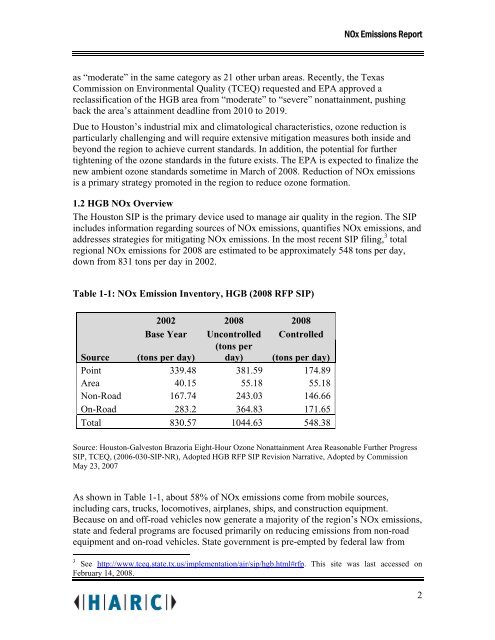NOx Emissions Impacts from Widespread Deployment of CHP in ...
NOx Emissions Impacts from Widespread Deployment of CHP in ...
NOx Emissions Impacts from Widespread Deployment of CHP in ...
You also want an ePaper? Increase the reach of your titles
YUMPU automatically turns print PDFs into web optimized ePapers that Google loves.
<strong>NOx</strong> <strong>Emissions</strong> Report<br />
as “moderate” <strong>in</strong> the same category as 21 other urban areas. Recently, the Texas<br />
Commission on Environmental Quality (TCEQ) requested and EPA approved a<br />
reclassification <strong>of</strong> the HGB area <strong>from</strong> “moderate” to “severe” nonatta<strong>in</strong>ment, push<strong>in</strong>g<br />
back the area’s atta<strong>in</strong>ment deadl<strong>in</strong>e <strong>from</strong> 2010 to 2019.<br />
Due to Houston’s <strong>in</strong>dustrial mix and climatological characteristics, ozone reduction is<br />
particularly challeng<strong>in</strong>g and will require extensive mitigation measures both <strong>in</strong>side and<br />
beyond the region to achieve current standards. In addition, the potential for further<br />
tighten<strong>in</strong>g <strong>of</strong> the ozone standards <strong>in</strong> the future exists. The EPA is expected to f<strong>in</strong>alize the<br />
new ambient ozone standards sometime <strong>in</strong> March <strong>of</strong> 2008. Reduction <strong>of</strong> <strong>NOx</strong> emissions<br />
is a primary strategy promoted <strong>in</strong> the region to reduce ozone formation.<br />
1.2 HGB <strong>NOx</strong> Overview<br />
The Houston SIP is the primary device used to manage air quality <strong>in</strong> the region. The SIP<br />
<strong>in</strong>cludes <strong>in</strong>formation regard<strong>in</strong>g sources <strong>of</strong> <strong>NOx</strong> emissions, quantifies <strong>NOx</strong> emissions, and<br />
addresses strategies for mitigat<strong>in</strong>g <strong>NOx</strong> emissions. In the most recent SIP fil<strong>in</strong>g, 3 total<br />
regional <strong>NOx</strong> emissions for 2008 are estimated to be approximately 548 tons per day,<br />
down <strong>from</strong> 831 tons per day <strong>in</strong> 2002.<br />
Table 1-1: <strong>NOx</strong> Emission Inventory, HGB (2008 RFP SIP)<br />
2002 2008 2008<br />
Base Year Uncontrolled<br />
(tons per<br />
Controlled<br />
Source (tons per day) day) (tons per day)<br />
Po<strong>in</strong>t 339.48 381.59 174.89<br />
Area 40.15 55.18 55.18<br />
Non-Road 167.74 243.03 146.66<br />
On-Road 283.2 364.83 171.65<br />
Total 830.57 1044.63 548.38<br />
Source: Houston-Galveston Brazoria Eight-Hour Ozone Nonatta<strong>in</strong>ment Area Reasonable Further Progress<br />
SIP, TCEQ, (2006-030-SIP-NR), Adopted HGB RFP SIP Revision Narrative, Adopted by Commission<br />
May 23, 2007<br />
As shown <strong>in</strong> Table 1-1, about 58% <strong>of</strong> <strong>NOx</strong> emissions come <strong>from</strong> mobile sources,<br />
<strong>in</strong>clud<strong>in</strong>g cars, trucks, locomotives, airplanes, ships, and construction equipment.<br />
Because on and <strong>of</strong>f-road vehicles now generate a majority <strong>of</strong> the region’s <strong>NOx</strong> emissions,<br />
state and federal programs are focused primarily on reduc<strong>in</strong>g emissions <strong>from</strong> non-road<br />
equipment and on-road vehicles. State government is pre-empted by federal law <strong>from</strong><br />
3<br />
See http://www.tceq.state.tx.us/implementation/air/sip/hgb.html#rfp. This site was last accessed on<br />
February 14, 2008.<br />
2
















